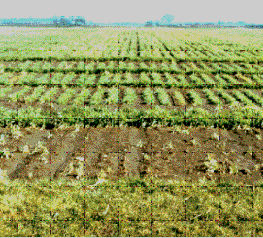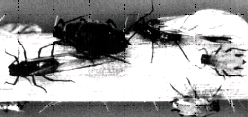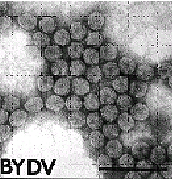Reports on Plant Diseases |
| RPD No. 101 -
Barley Yellow Dwarf Virus Disease of Small Grains |
May
1989 |
[ Symptoms
] [ Disease Cycle ][ Aphids &
Transmission of BYDV ][ The Virus ][ Control
]
| The barley yellow dwarf virus (BYDV) is spread by aphids and induces
probably the most widely distributed and most destructive virus disease
in the world. Besides small grains, many wild and cultivated grasses are
susceptible, although many of its hosts remain symptomless. Before 1951,
the cause was attributed to nutrient deficiencies and other factors. The
name describes the characteristic symptoms produced by the virus on susceptible
barley. The oat diseases formerly called "red leaf" and "gray
spot" are now known to be the same disease and are also caused by the
BYD virus.
In 1959 this virus, together with greenbug feeding, caused an estimated
loss of 34 1/2 million bushels of oats, amounting to $24.3 million and
represent 28% of the total oat production in Illinois. Severely infected
crops often yield no grain (Figure 1). Over large production areas, BYD
typically reduces yields by 5% to 25%
Damage to small grains varies with the cultivar, virus strain, time of
infection, and environmental conditions. The severity of BYDV damage depends
on plant response. Seedling infection is most severe. Late-planted spring
oats and oats growing in poor soils are damaged more severely than those
planted early in good soil. Oats following soybeans are less affected
than those following corn where no fertilizers have been applied.
Research work to develop well-adapted, highly tolerant oat and wheat
varieties is being conducted at the University of Illinois cooperatively
with the Agronomy and Plant Pathology Departments and the U.S. Department
of Agriculture.
Yellow dwarf first appears early in the season, usually along the margins
of small-grain fields, and later develops within a field in more or less
circular spots up to 30 feet or more in diameter. As the season progresses,
these diseased areas may enlarge and merge. When aphid populations are
high, entire fields may become affected (Figure 1). Distribution of the
disease within a field apparently depends on the colonization pattern
and preferential feeding of the aphid vectors. For example, the corn leaf
aphid (Figure 2) often prefers barley and avoids oats, causing a higher
disease incidence in barley. Farmers often fail to associate early aphid
infestations with yellow dwarf because symptoms usually do not appear
until two or three weeks after feeding. By that time the aphids may be
gone. The symptoms of early fall infections are often suppressed until
spring. Then the disease can be determined only by virus recovery tests
under controlled conditions in the greenhouse and laboratory.
|

Figure 1.
Severe yellow dwarf infection in oat field.
|
|

Figure
2. Corn leaf aphids feeding on infected plant (courtesy Dept. Plant
Pathology, Cornell University, W.F. Rochow).

Figure
3. Vermillion wheat dwarfed by BYDV fall infection. Taller rows are
healthy.
|
Symptoms
Symptoms typical of BYDV disease on small grains are often overlooked
and may be confused with other causes, e.g., mineral deficiencies, bacterial
toxins, leaf breakage, low temperatures, root and crown rots, and others.
Definitive diagnosis requires serologic tests such as enzyme-linked immunosorbent
assay (ELISA) and/or recovery and transmission of the virus by aphids.
The first symptoms on oats, and to a lesser extent on barley and wheat,
are the appearance of faint yellowish green blotches, usually near the
leaf tip. The blotches enlarge rather rapidly, merge, and turn various
shades of red, purple, brown, or yellow-orange. The yellowish green blotches
continue to appear on lower parts of the leaf before they change color.
Affected portions often die as the infection spreads through the entire
plant. The leaves may curl inward, are flexible, and appear more erect
than usual. Symptoms generally appear first on the older leaves. Late-infected
plants may develop symptoms only on leaves growing actively at the time
of infection. Blasting of florets also occurs; it may involve only a few
florets or, if severe, plants may fail to head. Kernels may shrivel and
test weight may be reduced.
In barley, the most characteristic symptoms are dwarfing and the brilliant
yellow coloring of the leaves which extends from the tip towards the base.
With late infections only the flag leaf may show symptoms.
In wheat, severe dwarfing and general yellowing are less common (Figure
3), and the disease is more severe when infection takes place in the fall
than in the spring. Although fall symptoms may be absent, infection predisposes
the plants to winterkilling, and disease is severe when new growth starts
the following spring. Yellowed or reddened leaves on otherwise normal
plants are often typical of postseedling infections. Some cultivars show
stunting but no leaf discoloration. Generally, the earlier the infection,
the more severe the disease with the root system damaged as severely as
the tops.
Yellow dwarf infection may not be proportional to the extent or duration
of the aphid infestation. Infestations are difficult to evaluate because
it is usually not possible to differentiate between the activity of aphids
as direct pests and as vectors of viruses. The amount of feeding damage
depends, for the most part, on the toxicity of the saliva injected during
feeding and on the number of insects infesting the crop. The outbreak
of the disease, transmitted ONLY by aphids, depends on the efficiency
with which a given aphid transmits the virus, the source and strain of
the virus, aphid mobility, feeding habits, and the age and susceptibility
of plants when infected, plus various climatic factors. The aphid species
responsible for the outbreak of disease may not necessarily be the most
abundant one. One very active aphid feeding for short periods on a number
of different plants is a much more important vector than 100 stationary
ones.
More than 20 species of aphids are known to transmit strains of BYDV.
Virus strains also differ in vector specificity. The oat bird-cherry aphid
(Rhopalosiphum padi) is the most efficient vector in Illinois.
The BYD virus is also spread by other species infesting small grains and
grasses, such as the greenbug (Schizaphis graminum), English
grain aphid (Sitobion [Macrosiphon] avenae) apple grain
aphid (R. insertum), corn leaf aphid (R. maidis),
and the rose grass aphid (Metopolophium dirhodum).
Virus-free aphids must acquire the barley yellow dwarf virus by feeding
on diseased cereal or grass plants for periods as short as 30 minutes
(more typically 12 to 48 hours) before they are capable of inoculating
healthy plants. The virus does not replicate in the aphids, but once they
acquire the virus, aphids are capable of transmitting it after a latent
period of 12 hours to four days, for the rest of their lives. All summer
forms of aphids transmit the virus equally well. Although some strains
of BYDV are transmitted by several aphid species, others are highly specific
to particular vectors. The quality of the BYDV protein coat and barriers
for virus passage from the aphid gut to its saliva are believed to be
involved. Specificity is also influenced by the physiologic and behavioral
characteristics of aphids, such as their ability to overwinter and multiply,
their feeding and flight habits, and their host preferences.
Back to Top
|
|
The Virus
BYDV is the type member of the luteovirus group. Its name is derived
from the Latin "luteo" which means yellow and describes the
most typical symptom of plants infected with luteoviruses. These viruses
are restricted to the phloem or food-conducting tissue in infected plants.
An electron microscope is required to visualize the virus particles or
virions. They are 25 nanometers (nm) in diameter and icosahedral in shape,
although sometimes they are referred to as spherical (Figure 4). The genetic
material in each particle is one single-stranded RNA molecule that has
a molecular weight of about 2 million daltons. The RNA is encased in a
coat of globular proteins of about 25,000 daltons.
Five strain groups of the BYD virus have been identified that differ
according to vector specificity and serologically. These groups can be
further subdivided into two subgroups (1 and 2) according to serological,
phytopathological, and other biochemical differences.
Disease Cycle
The barley yellow dwarf virus persists in small-grain cereals, in corn,
in more than 75 species of perennial and annual grasses, and in its aphid
vectors. The spread of BYDV from plant to plant and from field to field
depends entirely on aphid movement. In Illinois, winged aphids migrate
into small-grain fields in early spring from their alternate hosts and
overwintering grass and cereal crops in Illinois or from other states
as far south as Texas.
During the growing season, each adult aphid may produce from 10 to 20
young each day. The young aphids mature in a week or two. The daughter
aphids, normally wingless, reproduce and usually move only short distances
by crawling from plant to plant or by being blown on the wind.
When food is scarce, especially during the spring, winged forms develop
that migrate to other small grains and grasses, transmitting the virus
to these plants as they feed. Infected cereals and grasses serve as a
virus source for new generations of aphids. In the fall, the aphids migrate
to winter hosts – in the process, spreading the virus to fall-seeded
small grains. Infected winter barley, wheat, and oats, as well as perennial
grasses become important virus reservoirs for spread of the disease in
the spring. Eliminating aphids at the virus-reservoir sites, especially
along roadsides, fencerows, drainage ditches, wooded areas, wastelands,
and permanent pastures, may be a way of preventing the spread of the barley
yellow dwarf virus.
BYD epidemics are most common in cool (50 to 66 F, 10 to 18 C), moist
seasons that favor growth of small grains and grasses as well as the multiplication
and migration of aphids. Aphid flights may be localized or, when aided
by wind (including low-level jet winds), may cover many hundreds of miles
from south to north in the spring and north to south in the autumn. BYD
infections occur throughout the growing season, but are most common and
damaging in spring in areas where the aphids overwinter. Inoculated plants
become systemically infected and develop symptoms within two weeks at
68 F (20 C), within four weeks at 77 F (25 C), but not at all above 86
F (30 C). The barley yellow dwarf virus is NOT transmitted through eggs,
newborn aphids, seed, soil, sap, or other insects.
Back to Top
|

Figure 4. Stained
icosahedral particles of BYD virus under electron microscope.
|
|
Control
- At present, BYDV cannot be fully controlled in the field. Damage
in oats as well as in other crops can be greatly reduced by growing
tolerant varieties. No major gene(s) for resistance to BYDV have been
found in wheat and oats. In barley, the gene Yd2 confers resistance.
Plant breeders, in cooperation with plant pathologists, have developed
and are continuing to develop tolerant oat varieties. Winter wheats
are also available with moderate resistance. For the latest information
on recommended small-grain varieties for Illinois consult the University
of Illinois Agronomy Handbook and University of Illinois Extension
Pest Management Handbook. Both publications are revised annually
available at your nearest county Extension office.
- Plant winter wheat, barley, and oats as late as practical, but after
the Hessian fly-free date. Late summer and early autumn plantings are
most subject to severe infection and should be avoided. Late-autumn
planting helps winter cereals to escape a buildup of aphids in the fall.
- Early planting of spring varieties plus proper soil fertilization,
based on a soil test, can help to prevent severe damage. Vigorously
growing plants are more tolerant of the disease than weaker ones. Large
populations of aphids usually do not appear in Illinois until late May.
A very early appearance of aphids, such as the one with greenbugs in
1959, is an exception rather than the rule.
- Where feasible, avoid double-cropping. Volunteer wheat and barley
are important reservoirs of the virus.
- The use of insecticides to control BYDV in small-grain and grass crops
is not recommended at present. Contact insecticides act directly on
aphids, but have a short residual effect. Upon entering the plant tissues,
systemic insecticides act as a poison to the feeding aphids for varying
lengths of time. If such an insecticide acts quickly, it may kill the
insect before it can inoculate another plant. Some insecticides, however,
may even increase aphid mobility and help to spread the virus. The plant
from which the insect gets the insecticide does not escape infection.
In some cases, though, it may prevent the virus-carrying aphid from
inoculating other plants. Unfortunately, this type of insecticide will
not keep infection from coming into a treated field from outside. If
virus-carrying aphids arrive in steady numbers from beyond the treated
area, they can infect the plants on which they land and feed even if
these have been treated.
Back to Top
|
For further information concerning diseases of crucifers
and other vegetables, contact Mohammad Babadoost, Extension Specialist in Fruit
and Vegetable Pathology, Department of Crop Sciences, University of Illinois
at Urbana-Champaign.
University of Illinois Extension provides equal
opportunities in programs and employment.
|



